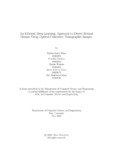An efficient deep learning approach to detect retinal disease using optical coherence tomographic images
Date
2022-05Publisher
Brac UniversityAuthor
Khan, Farhan SakibFerdaus, Nowshin
Hossain, Tamim
Islam, Quazi Sabrina
Islam, Md. Iftakharul
Metadata
Show full item recordAbstract
Optical Coherence Tomography (OCT) is an effective approach for diagnosing retinal
problems that can be used in combination with traditional diagnostic testing
methods. We developed and implemented a deep Convolutional Neural Network
(CNN) model, which has the capability to effectively identify and classify Optical
Coherence Tomography (OCT) images into the following four categories: Normal,
DMD, CNV, and DME. The proposed 21 layered CNN model is built with three
basic layers: a convolutional layer, a pooling layer, and a fully connected layer along
with dropout and dense layers. Our proposed model is able to detect and differentiate
between the OCT images with a high amount of accuracy. The 21 layer proposed
CNN model was used for the classification and diagnosis of retinal sickness using
OCT images. To justify the efficiency of our custom CNN model, seven pre-trained
CNN models (VGG16, VGG19, MobNetV2, Resnet50, DenseNet121, InceptionV3,
and InceptionResNetV2) were used and testified with the same amount of dataset.
In terms of the accuracy, precision, recall, and f1 score, which are all tested in this
paper, the suggested CNN model along with seven other pre-trained CNN architectures
perform comparable on the available dataset. The proposed model has an
accuracy rate of 98.37 percent, which is greater than any of the experimental results
of the CNN models utilized in this research due to the fact that the recommended
model was developed. When it comes to the diagnosis of retinal problems, the
CNN model that was suggested performs far better than any other model that was
previously used.

